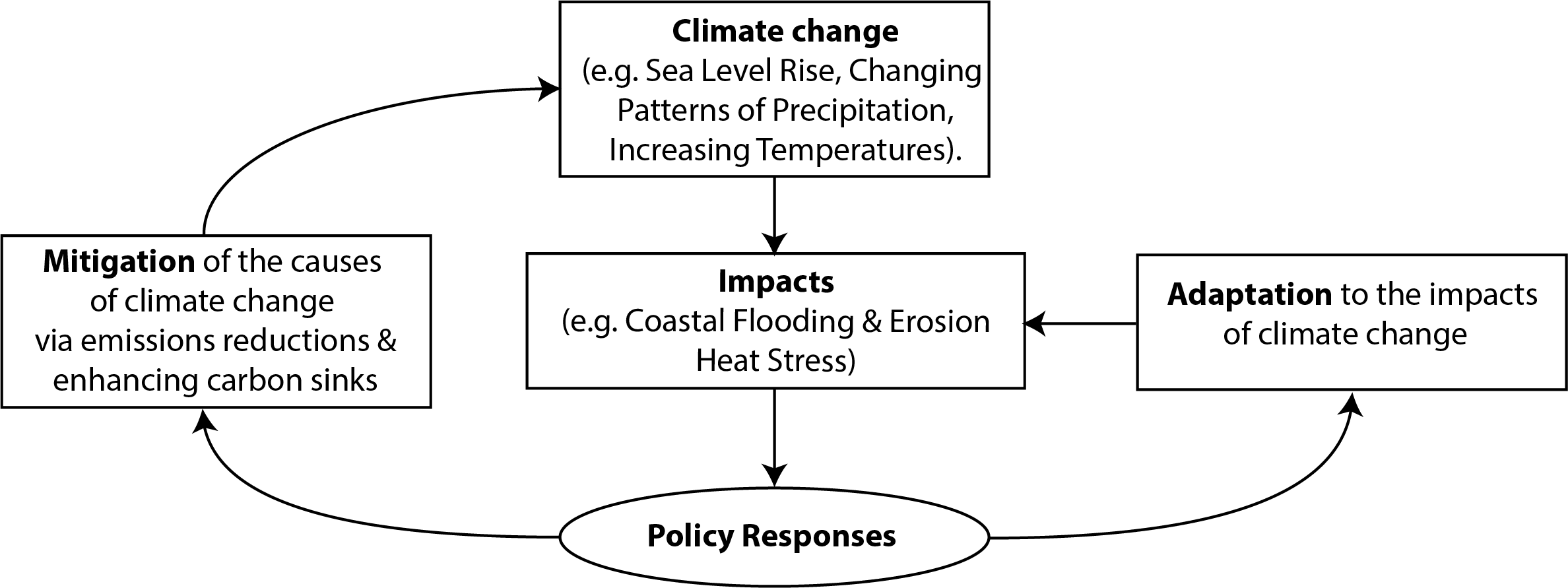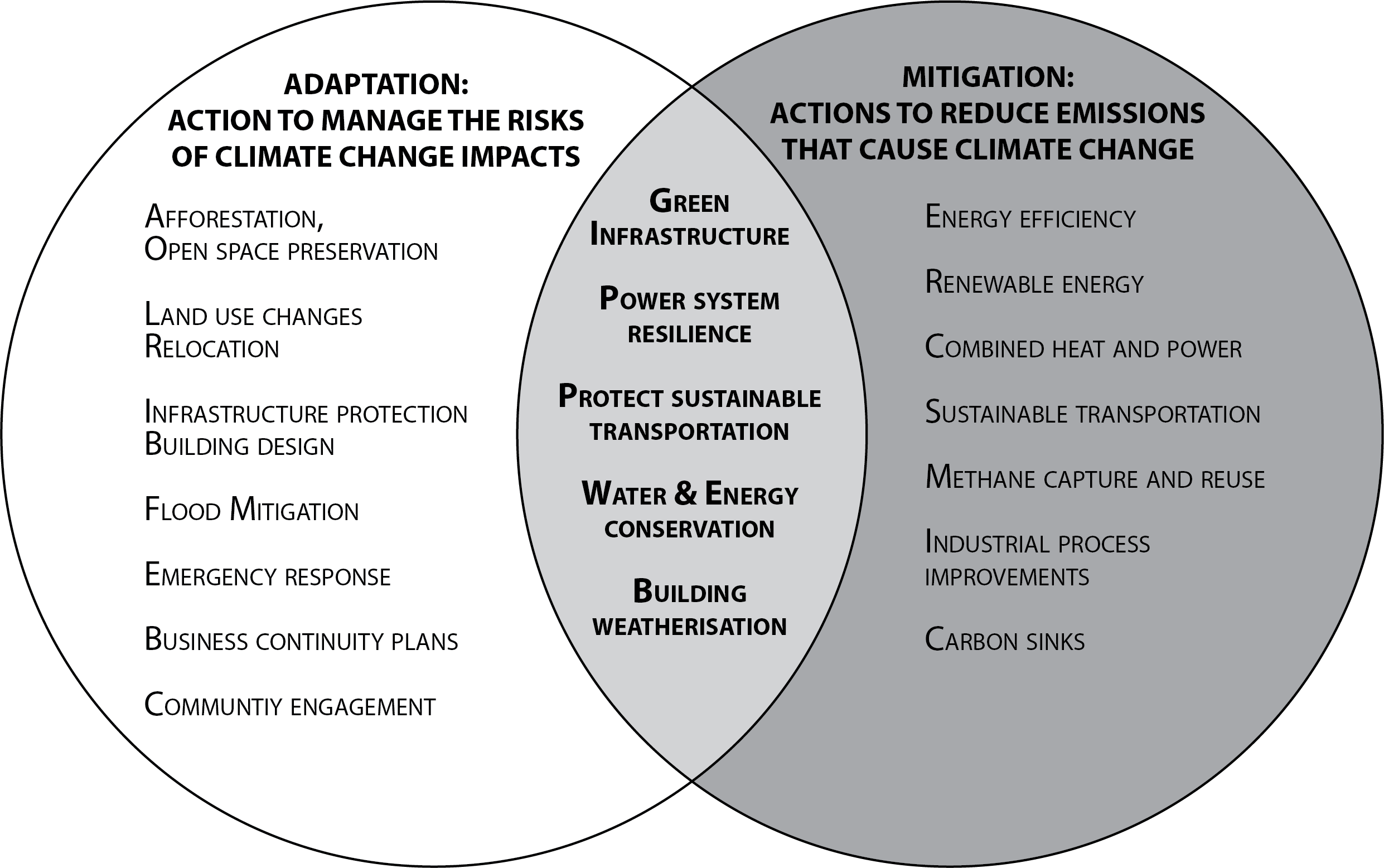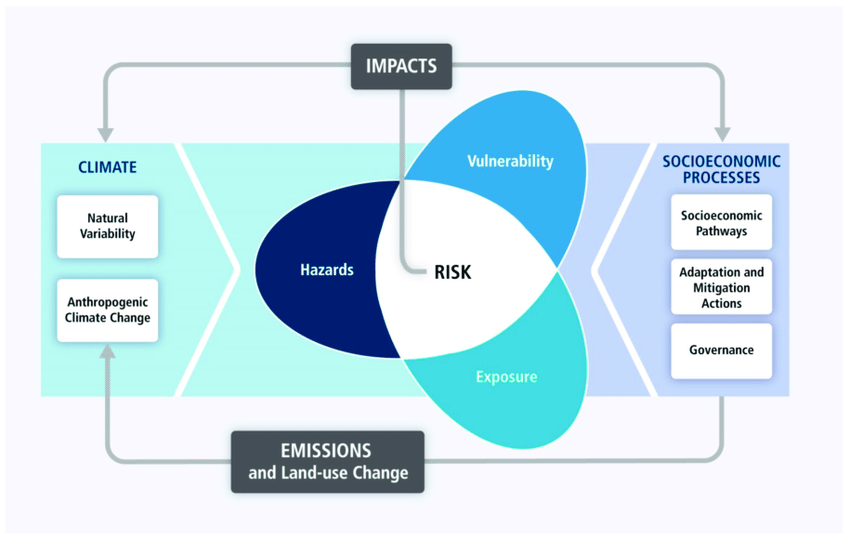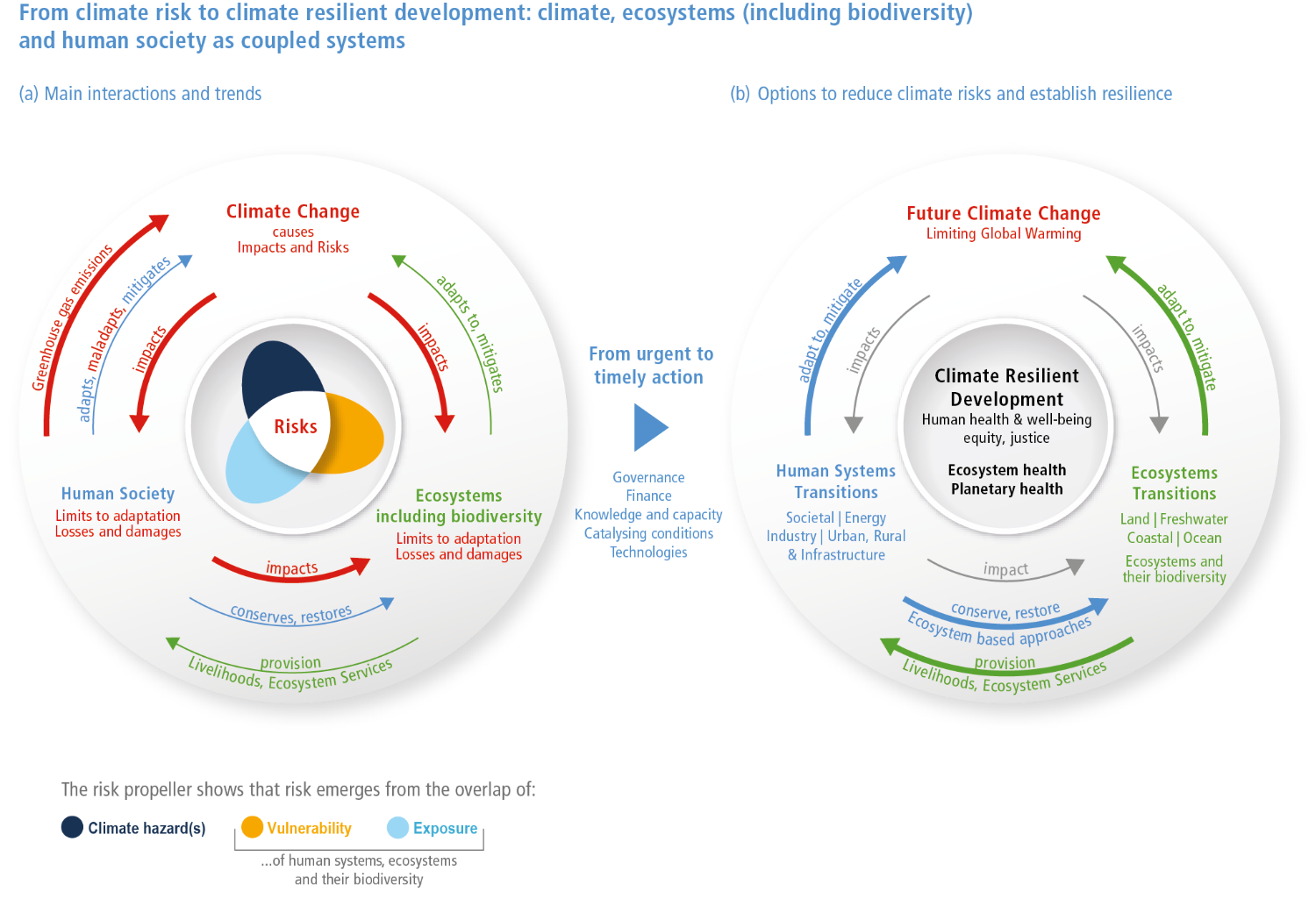What is climate adaptation
Key information
Adaptation aims to ensure that we are better prepared to respond to current and future climate change impacts. As our climate changes, we will need to make adjustments and adapt to the changing climatic conditions. This might involve making changes to our buildings to ensure that they keep cool during hot summers or using water resources more efficiently.
Planned adaptation aims to create more climate resilient communities by taking proactive steps to prepare for the impacts of projected climate change.
Adaptation and mitigation

Mitigation actions focus on limiting the rate and scale of future climate change by reducing levels of greenhouse gas emissions and increasing GHG sinks. Adaptation actions aim to reduce the impacts of climate change and also to take advantage of any opportunities presented by climate change.
- Climate is changing and the effects of these changes are expected to continue and intensify into the future;
- Mitigation and adaptation are two complimentary approaches employed in responding to climate change;
- Mitigation aims to tackle the causes of climate change by reducing emissions of greenhouse gases or by enhancing the capacity of carbon sinks, e.g. through afforestation;
- Adaptation has been defined by the Intergovernmental Panel on Climate Change as the process of "reducing climate risks and vulnerability mostly via adjustment of existing systems" (IPCC 2022);
- In other words, adaptation aims to ensure that we are better prepared to respond to current and future climate change impacts by reducing our vulnerability to climate change;
- Risk of climate change is determined by three factors: climate change hazards (such as increased rainfall), exposure to these hazards (for example, where houses are located in flood plains), and vulnerability to these hazards (for example, age profiles or availability of transport);
- Planned and pre-emptive adaptation is required to cost-effectively minimise potential climate change risks;
- Adaptation actions aim to reduce risk of climate change by limiting exposure and vulnerability;
- Adaptation actions can be 'grey', that rely on technological or engineering solutions, 'green' that make use of nature, and 'soft' that aim to alter human behaviour and styles of governance;
- In reality, adaptation will involve a mix of adaptation responses or 'combined adaptation actions' that will include grey, green and soft adaptation actions, autonomous and planned adaptation.
Building resilience to climate change impacts

Adaptation and mitigation are two necessary and complementary routes of action that address two different aspects of climate change.
Adaptation and mitigation can and should work in an integrated manner to maximise co-benefits and to decrease the impacts of climate change on lives and livelihoods.
Detailed explanation
Global climate is now changing in an unprecedented manner. The impacts of these changes are already evident, and the rate and scale of these changes is expected to increase and intensify into the future.
Without taking appropriate actions to address the impacts of climate change and take advantage of the opportunities presented by these changes, potentially disastrous consequences can be expected.
Climate change will mean that extreme events such as the European heat wave of summer 2003, which is estimated to have resulted in up to 70,000 deaths from heat induced illnesses, are expected to occur more frequently. [ref].
Mitigation and Adaptation
Mitigation and adaptation are two complimentary approaches employed in responding to climate change. Mitigation refers to efforts to tackle the causes of climate change while adaptation focusses on making adjustments to ensure that we are better prepared for climate change impacts.
Mitigation
An anthropogenic intervention to reduce the anthropogenic forcing of the climate system.
Mitigation involves strategies to reduce emissions of greenhouse gases that are driving climate change, but may also be achieved by increasing the capacity of carbon sinks, e.g. through afforestation. However, a certain level of climate changes is now inevitable because GHGs persist in the atmosphere for hundreds of years so even if emissions of these gases ceased tomorrow, the climatic effects of historical greenhouses gas emissions would stay with us for the foreseeable future.
Adaptation
Adjustment in natural or human systems in response to actual or expected climatic stimuli or their effects, which moderates harm or exploits beneficial opportunities.
Adaptation consists of actions that respond to current and future climate change impacts (as well as to the climate variability that occurs in the absence of climate change). Adaptation seeks to not only protect people, buildings, infrastructure, businesses and ecosystems against the negative impacts of climate change, but also aims to build resilience to climate change, allowing society to take advantage of any opportunities that it might bring [ref].
Planned adaptation
Planned adaptation aims to take actions to counter current or expected climatic impacts within the context of ongoing an expected societal change.
Due to our increased knowledge of expected climate change impacts, we can now develop planned adaptation responses. By anticipating and planning for climate change impacts, it is possible to reduce the costs and maximise the effectiveness of adaptation actions. Importantly by proactively planning for climate adaptation, we can avoid maladaptation.
Maladaptation describes an action that results in an undesirable and unintended outcome(s). This leads to increased vulnerability, which the action was meant to reduce.
Risk framework

Conceptual risk framework consistently adopted by IPCC since Special Report on Global Warming of 1.5ºC, 2018 [source: IPCC, 2018]
Climate risk is a conceptual framework about the functional relationship between different elements: exposure, vulnerability and hazards. Hazards relate to the probability of climate event to occur. This then combines with the consequences (exposure to hazards and vulnerability to hazards). Planned adaptation aims to reduce the risk of climate impacts and increase overall resilience of systems and places.

IPCC AR6 WG2 action-risk-resilience framework. The recognition of climate risks can strengthen adaptation and mitigation actions and transitions that reduce risks. Taking action is enabled by governance, finance, knowledge and capacity building, technology and catalysing conditions. Transformation entails system transitions strengthening the resilience of ecosystems and society [source: IPCC, 2022]
Planning for adaptation
As the impacts of climate change vary spatially and on a local basis, high-level adaptation policy is typically developed by central government but local differences in social and cultural norms, physical environment, land use and economics make adaptation decision-making principally the concern of regional and local scale administrators, businesses and the general public [ref].
The process for planning for climate change adaptation is a continuous and iterative cycle and there are a wide range of planning frameworks available to help you in your planning. Generally, these frameworks adopt a stepped approach to adaptation planning and follow several steps:
- Information collection and awareness raising;
- Planning and design;
- Implementation;
- Monitoring;
- Evaluation.

Conceptual framework showing (in the shaded area) the steps involved in planned adaptation to climate variability and change [source: Klein et al., 2006]
Adaptation responses
Due to our increased knowledge of expected climate change impacts, it is now necessary to develop planned adaptation responses. By anticipating and planning for climate change impacts, it is possible to reduce the costs and maximise the effectiveness of adaptation actions. The type and scale of planned adaptation responses are determined both by the vulnerability of a given system to climate change impacts, and its inherent capability to adapt (adaptive capacity) - National Coastal Erosion Committee, 1992. Coastal Management - A Case for Action. Eolas on behalf of the County and City Engineers Association. Dublin.
Adaptation responses can be usefully characterised under three broad categories:
- "Grey" Actions: technological and engineering solutions. Examples include building or strengthening coastal defences - rock armour installed on Cape Clear to protect against coastal erosion is an example of a 'grey' adaptation action.
- "Green" Actions: ecosystem based approaches that use the multiple services of nature - Connswater, Northern Ireland, provides an example of green adaptation measure where where a linear 9km park is being created through east Belfast as part of the East Belfast Flood Alleviation Scheme.
- 'Soft' Actions: managerial, legal and policy approaches that alter human behaviour and style of governance - Ireland's National Climate Change Adaptation Framework provides an example of soft adaptation measure.
In general, 'Green' and 'Soft' actions are generally less resource intensive and typically provide multiple benefits where as 'Grey' solutions often require high levels of capital investments and a lower level of flexibility to changing circumstances.
As the exact nature of future climate remains uncertain, adaptive responses can be further characterised according to the extent to which they are justifiable under different scenarios of climate change.
- 'Low regret' adaptation options are functional and provide benefits under a wide range of climate scenarios. As a result, 'Low regret' options are particularly favoured by policymakers;
- 'High regret' adaptation options are sensitive to the choice of climate change scenario and would only make sense under a few climate change scenarios.
Resources
- NASA - Global Climate Change, Vital Signs of the Planet: Solutions: On these pages, NASA provides an overview of our responses to climate change (mitigation and adaptation).
- Climate Change 2022: Impacts, Adaptation and Vulnerability: The Working Group II contribution to the IPCC Sixth Assessment Report assesses the impacts of climate change, looking at ecosystems, biodiversity, and human communities at global and regional levels. It also reviews vulnerabilities and the capacities and limits of the natural world and human societies to adapt to climate change.
- US EPA - Adapting to Climate Change: The US EPA provides an overview of climate adaptation and planning.
- Sectoral Planning Guidelines for Climate Change Adaptation (2018): These guidelines aim to ensure that a coherent and consistent approach to adaptation planning is adopted by the key sectors in Ireland. Sectors preparing sectoral adaptation plans under the NAF are required to prepare their plans in line with the process described in these guidelines.
- National Risk Assessment of Impacts of Climate Change: Bridging the Gap to Adaptation Action: This report presents its findings according to the NAF’s four themes: natural and cultural capital, critical infrastructure, water resources and flood risk management, and public health. The impacts of climate change will have direct relevance to the achievement of planning and development objectives and priorities within these themes.
